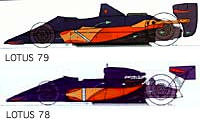Ground Effect - A Quick Overview
The Lotus 78 was the first "ground effect" car. So what exactly is "ground effect"?
"Ground Effect" - A Quick Overview
The concept of "ground effect" is that if the bottom of the car is shaped correctly (i.e. like a plane wing, but upside-down), an area of low pressure forms under the car, resulting in the car being sucked to the ground. This in turn will give the car more grip, thus making it perform better.
To quote Colin Champan - "Well for years of course we've been concerned with the effect that air has when it flows over the car and we've been trying our best to stop it flow under the car. What we're really trying to do is to promote air flow under the car in order to be able to contour the underside of the car so that it provides a negative lift (i.e. downforce or grip). In other words the air passing under the car helps to hold it on the road. It holds the car down, it improves the grip of the tyres on the road, it improves the stability of the car, it improves the safety of the car."

Air flow for the Lotus 79 and 78
The History Of "Ground Effect"
In summer 1975 the Lotus Formula 1 team were in deep trouble. The Lotus 72 was now obsolete and totally uncompetative, and attempts to build a replacement (The Lotus 76) had met with failure. Colin Chapman said of this time "I sat down and thought really seriously about what we wanted, and decided the answer was a wing car...". He compiled a 27 page concept document specifying his requirements and handed it to his engineering director Tony Rudd for him to set up a new research and development department. This was a month before the release of the Lotus 77.
As Rudd says of this document "He realised that in racing we were down and out, and that we had got it wrong by the latest standards. He made the right long range strategic decisions while still involved in day-to-day racing. Not only did his 27 page document suggest a way to go, but he also listed all the things he didn't know, and then left it to an old has-been like me and a bunch of new boys to tell him the answers..."
Rudd had been at BRM, and had been resposible for many of their finest cars and designs. In 1969 just before he left, he and his aerodynamicist assistant Peter Wright had a 'wing car' concept of their own in the early stages of development. In late 1975 Rudd, Wright and Ralph Bellamy discussed Chapman's proposal in detail. The basic philosophy was simple; to use the car's underbody shape to generate downthrust as it moved through the air, similar to the way in which the contemporary added on wings provided downthrust from their upper surfaces. Together with pattern maker Charles Prior they went to Imperial University to fine tune the concept and produce a new car design.
The Lotus 78 was completed in the summer of 1976, and was thoroughly tested before entering the 1977 season. The concept did work, but the downforce generated was only 75% of that predicted. According to Mario Andretti, the 78 cornered "...as if it's painted to the road...". One of the drawbacks of the 78 was that while it was fast in the corners, it was off the pace along the straights. This, combined with reliability problems and driver error, saw Lotus miss out on the driver's and constructor's championships.
For the beginning of the 1978 season, the 78s carried on, as the Lotus 79 was being developed. The aim with the 79 was to find the 'missing' 25% downforce. This was to be done by improving the airflow through the sidepods. In the meantime other teams tried out "ground effect", the most successful and obvious being the Brabham BT46B "Fan Car". The 79 turned out to be even better than the 78, as was proved when Andretti got pole in Zolder a full second faster than the rest of the field. He commented on the 79 "...really fast tracks were something I'd got to dread with the 78, but the 79 was really strong on the straightways. We could run with anybody." Lotus wiped the floor with the rest of the field in 1978 with Andretti winning the driver's championship and Lotus winning the constructor's championship.
Unfortunately "ground effect" turned out to be the un-doing of Lotus in the 1979 season. It was reasoned that increasing the underwing area would provide more grip and higher lap speeds. The Lotus 80 was built along those lines, but proved to be uncompetative. The 79 was made faster, but the other teams had caught up. Combined with the stress generated by new Goodyear tyres, the 79 lost its reliability, and saw the end of Lotus' return to form. Meanwhile other teams capitalised on their new-found knowledge of "ground effect" with the Ligier JS-11 and Williams FW07 winning 8 races between them giving the V12 powered Ferrari 312Ts something to worry about.